Reflections: James C. Wyant
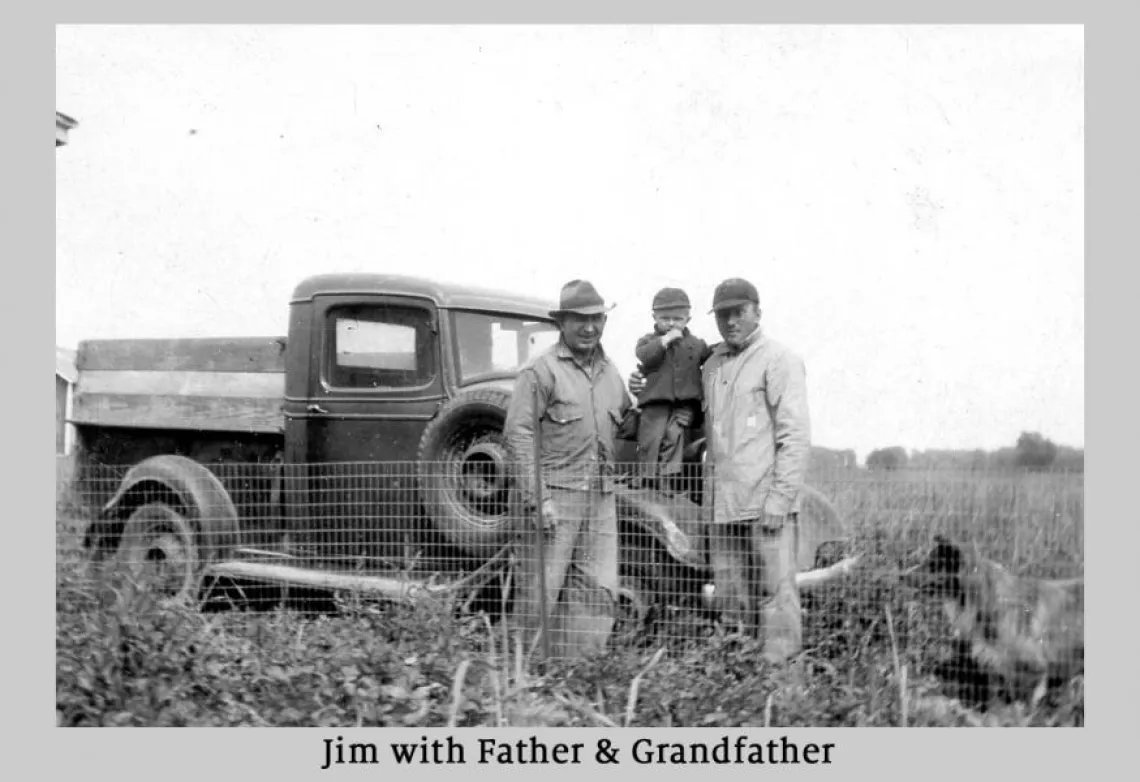
Diligence is the mother of good luck.
(Benjamin Franklin)
If you were to ask Professor Emeritus James (Jim) C. Wyant what has led to his success, he would most likely—as he has many times—say, “luck and timing.” And while many people would agree that luck can create some level of opportunity, nothing enables greater career success than working harder and caring more.
Early Life
Born 31 July 1943, to Clair and Idah May Wyant, Jim grew up on a farm outside the small Ohio town of Lyons. From the age of four years old, he could often be found in a small workshop his father had equipped for him—discovering the mechanics of how things worked and inventing useful gadgets. Jim recalls two of his earliest inventions—an automatic baseball pitching machine, triggered by the movement of his foot; and an intercom system between his workshop and the house, enabling his mother to easily call him for dinner.
When Jim was five years old, his father was tragically killed in a farming accident, and 30 minutes later, his paternal grandfather died from a stress-induced heart attack. With determination—and a stereotypical Midwestern work ethic—the family persevered. By the time Jim was a freshman in high school, he had taken over the running of the farm, growing corn and soybeans. Additionally, he raised and sold more than 28,000 chickens a year and ran a thriving hay business, employing several of his classmates.
Despite having to work long hours on the family farm, Jim still managed to keep excellent grades in school, and felt early on that knowledge was the path to success— his goals in life were always to become a professor and an inventor; and to start a company selling his inventions. In his spare time, he learned the basics of electronics as an amateur ham radio operator, finding it exciting to build equipment that enabled him to talk with people around the world.
Undergraduate Education
After graduating from Lyons Village School in 1961, Jim decided to study Physics at Case Institute of Technology (CIT) in Cleveland—now, Case Western Reserve University (CWRU). His school and major of choice were influenced by two things: someone from his town had attended CIT five years before him; and Jim had grown up knowing his father had won Ohio’s State Physics Competition his senior year in high school. During Jim’s four undergraduate years, he ran track and cross country—inspiring a life-long appreciation for exercise and physical fitness. (In 2016, CWRU honored Jim by inducting him into the Spartan Club Athletic Hall of Fame.)
As Cleveland was only four hours from Lyons, Jim spent many weekends and all breaks commuting back to his home to help maintain the farm. Between his junior and senior years, he decided it would be beneficial to get some hands-on experience in his career field, so he secured a summer job in the Corporate Technology Center of the Libbey-Owens-Ford Glass Company (LOF) in Toledo. As the top producer of flat glass for the automotive industry, LOF had a need for flawlessly polished surfaces. To this end, Jim developed a method to detect surface-scatter of light during the manufacturing process—his first introduction to the field of optics.
Jim’s second introduction to optics came at the start of his senior year at CIT, and his plan to study solid-state physics changed immediately.
During my first senior lab, I saw my first laser and my first hologram. Professor Richard (Dick) Hoffman illuminated a cloudy glass plate with a Helium-Neon laser. A stapler appeared that looked so realistic, I actually tried to grab it. I remember thinking that I just had to learn the science behind creating this amazing 3-D image
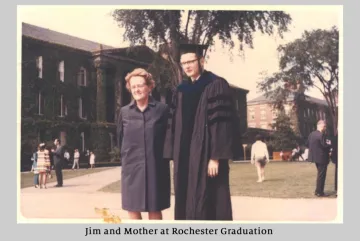
Graduate Education
In 1965, after receiving his B.S. degree in physics, Jim began his graduate studies at the University of Rochester’s Institute of Optics. Expecting to be a teaching assistant, he was told, instead, he was being offered a position as a research assistant—working with Professor M. Parker Givens, whose research spanned several topics in physical optics, including holography and photogrammetry. Jim’s first assigned project was to make several holograms to learn about the holographic process.
Later, at the suggestion of professor Givens, Jim chose his Ph.D. thesis topic to be “Effects of Photographic Gamma on Hologram Reconstructions.” After a few months in the lab, he learned something that has stood the test of time longer than his holographic research—the value of attending colloquiums, even if the topic is not directly related to your interests. Sometimes going outside your narrow discipline, has a high-value payoff.
When I first started my research, the experimental data I was collecting was not agreeing with my theoretical data. Then one day, I happened to attend a lecture given by Dr. George Bird, a scientist at Polaroid. I don’t recall exactly what the topic of his lecture was, but I do vividly remember the short chat I had with him afterwards about my research—and how a few short words of advice from him favorably changed the outcome of my results. From that day on, I always realized the importance of providing students with opportunities to interact with experts from many different disciplines.
After completing his Ph.D. in optics in August 1968, Jim headed back to Lyons—picked up his mother, grandmother, grandfather, and a tin of his grandmother’s home-baked cookies—and hit the road for a “let’s see as much of the United States in two weeks that we can” trip. The interstate-highway system was just materializing from coast to coast, and the foursome took full advantage—enjoying the beautiful scenery and, more importantly, each other’s company through 20 states. These trips became a yearly tradition, and still remain some of Jim’s fondest memories.
Industry
After returning from his whirlwind family vacation, Jim had one more drive to make—to Burlington, Mass., to start his job as an optical engineer at Itek Corporation. He initially worked on computer generated holograms for testing aspheric optics then, later, the development of phase-shifting techniques for transferring interferometric data to computers, and wavefront sensors for adaptive optics.
I first became acquainted with Itek as a student at Rochester. Robert (Bob) Shannon, then-director of Itek’s Advanced Technology Labs, would come to the University to recruit students, and many of us even visited their facilities in Lexington, Mass. once a year. At the time, Itek was at its peak and the visit included a helicopter ride from their office back to Logan Airport!
For almost six years, my job at Itek was nearly ideal—except that Bob had left Itek to be a professor at the University of Arizona’s Optical Sciences Center (OSC) eight months after I arrived to work in his group. We had freedom to choose our own projects; plenty of money for equipment; and very smart people to work with. We even had a team of marketing people who brought us interesting problems we could work on if we wanted. And, to top it off, I was encouraged to attend professional society meetings; and given the flexibility to also teach physics and math at Lowell Technological Institute.
From Industry to Academia
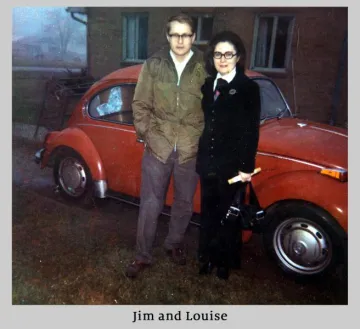
In 1974, Bob Shannon, then-OSC professor, decided to take a chance on Jim once again, and asked him to consider applying for a faculty position at the University of Arizona. Jim’s desire to be a university professor was stronger than ever—as he was thoroughly enjoying his time teaching at Lowell Tech—so he readily decided to apply.
In preparation for his interview in March at OSC, Jim prepared flashcards of every professor, including their alma mater and research area. He even had his wife, Louise, test him on the material. Unfortunately, the one person he did not think of including was the university president.
After nearly a full day of meetings with faculty, OSC’s director Peter Franken, told me I had one more interview—with President John Schaefer. As this was before the days of having a mobile computer in my shirt pocket, I had no way of getting biographical information. Needless to say, I was nervous. But, upon walking into president Schaefer’s office, I spotted a football on the table beside his desk. For some reason, that calmed me down—perhaps, it was just that I now had an opening.
Toward the end of July—after convincing Louise’s parents they would absolutely have indoor plumbing in Tucson—Jim, Louise, and their two cats drove from Massachusetts to Arizona in their clementine orange VW bug.
Optical Science Center (OSC)

Starting at OSC as an assistant professor, Jim quickly set up a lab and began to build a research group. At first, professor Shannon, who had encouraged Jim to come to Arizona, provided him with projects and financial support. But, within the first month, individuals at Los Alamos National Lab—who had previously funded Jim at Itek—offered to continue their support. This led to a funding partnership that would span over 10 years.
Jim’s research group focused on the implementation of computers and software to interferometric techniques for optical measurements—in particular for optical testing; testing of super-smooth optical surfaces; measurement of optically rough surfaces; and testing of complex aspheric surfaces—and the development of commercial optical test equipment based on phase-shifting interferometry.
Not only did Jim quickly integrate into the work of OSC, but he also found it easy to be part of the culture of the Center.
From the very beginning, I found OSC an exciting place to be. We were on the forefront of optics research, and the Center was like a family. Outside the workplace, there were many opportunities for socializing and friendly competition. Some of my favorite memories are of the yearly races in Saguaro National Park, the annual fall picnic, and caravanning to the SPIE conference in San Diego. These events were a lot of fun for me and Louise—and later, our son, Clair.
For a look at the exploits and adventures of OSC’s earliest years, view Light Moments, a series of short, light-hearted articles in honor of OSC’s 50th anniversary.
First Goal: Become a Professor
In 1979, Jim was promoted to full professor. Two years later, a visit to the Union Carbide Y-12 plant in Oak Ridge, Tenn. would put him on the path to achieving his other two life goals—becoming an inventor and starting a business.
Union Carbide was making diamond-turned mirrors for their laser fusion system and parts for the atomic bomb. I saw they were using several interference microscopes to determine the surface finish of the diamond-turned mirrors and parts. They took Polaroid pictures of the interference fringes, then several people analyzed the interferograms using a ruler and pencil to determine how straight the interference fringes were. I figured there had to be a better way of determining the surface finish. From this challenge, WYKO Corporation was formed.
WYKO Corporation
Upon returning to Tucson from Oak Ridge, Jim contacted two friends at Los Alamos National Lab, Tom Stratton and Walt Reichelt, to see if they would fund the development of a better way of measuring the surface finish of the diamond-turned mirrors and parts they were making. They almost immediately gave him funding.
I found a student, Chris Koliopoulos, to work on the project for his Ph.D. dissertation. By this time, some Reticon detector arrays were available, and the Z80 microprocessor had just come on the market. After a little fumbling and borrowing some interference microscope parts, we were able to put together a crude phase-shifting interference microscope system.
On Dec. 27, 1982, WYKO Corporation was founded to design, manufacture, sell and service metrology instruments for many applications—with the largest market being in the magnetic data-storage industry. The founders, along with Jim, were Chris Koliopoulos, who by then had completed his Ph.D. and was an assistant professor at OSC; Keith Prettyjohns, Jim’s post-doc; and Steve Lange, an optical researcher working on Jim’s projects.
For the complete story of the formation, growth and eventual selling of WYKO Corporation, read Wacko WYKO, written by Jim for SPIE. [Wyant, J. (2008). Wacko WYKO. In J. Lopez-Higuera & B. Culshaw (Eds.), Engineering a high-tech business: entrepreneurial experiences and insights (pp. 113-120). Bellingham, WA: SPIE.]
Return to OSC to Full-Time
By 1996, Jim felt it was time to sell WYKO. While he was still having fun—dividing his time between running WYKO and still teaching classes at OSC—Jim found he really missed being at the University full-time.
Four companies were interested in buying WYKO, but we decided to sell to Veeco Instruments in 1997. Essentially, every manufacturer of hard-disk drives in the world was using WYKO’s equipment for evaluating hard disks and recording heads. Veeco made the equipment to manufacture the disks and heads, and we made the equipment to test them, so it seemed like a good match.
After the sale of WYKO was finalized, Jim returned to his lab and to the classroom. He taught courses in diffraction, interferometry, holography and optical metrology; and throughout his academic career, he would be the major professor for 34 Ph.D. and 25 M.S. students.
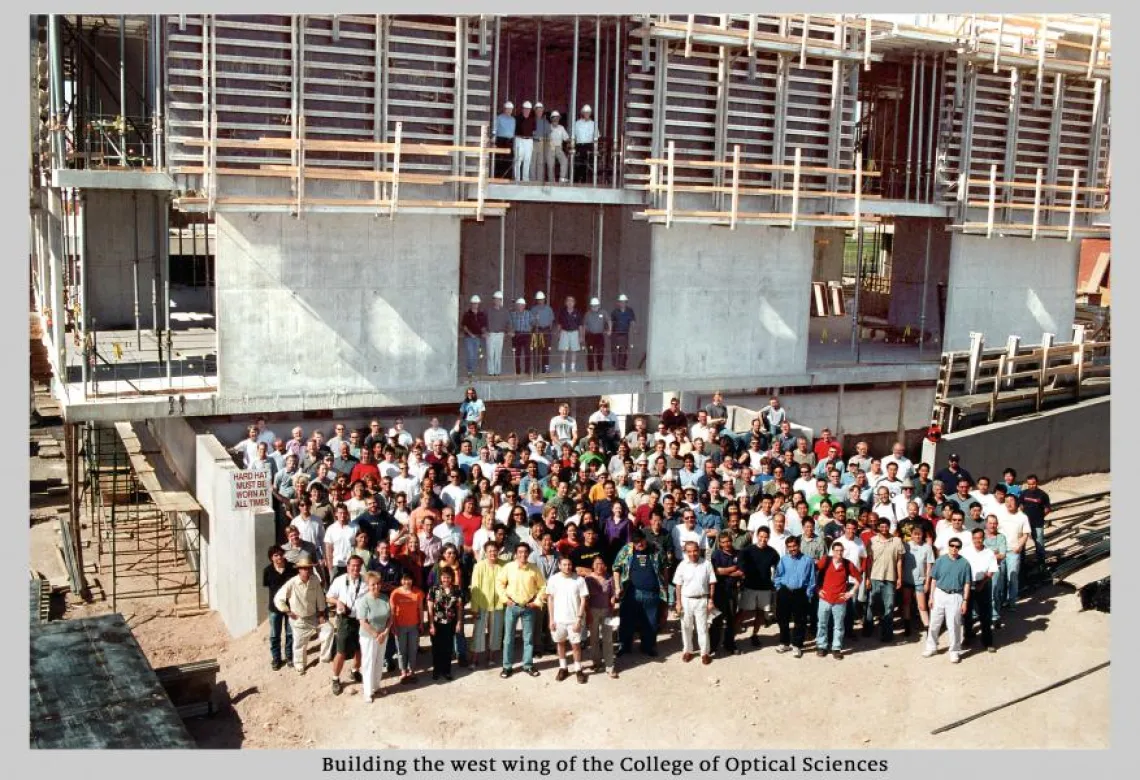
Later, in 2002, Jim would be the co-founder of another company, 4D Technology Corp., to develop and manufacture metrology instruments for accurate measurement of optics in the presence of severe vibration and turbulence. One of 4D’s major projects was the testing of the primary mirror and back structure for the James Webb Space Telescope. The final testing was conducted in Houston in 2017 during Hurricane Harvey!
OSC Leadership/Retirement
In 1999, Richard (Dick) Powell stepped down as director of OSC, and Jim became the Center’s fifth director. During his tenure as director, the undergraduate program achieved ABET accreditation, and the Center experienced significant program growth, increasing faculty and nearly tripling the size of the student body.
Right from the beginning of my time as director, I felt that OSC needed to be a College—for greater recognition within the University and around the world. I wrote a few key milestones I felt would need to be achieved to make that happen on an index card and carried it around in my shirt pocket. From time to time, I would take the card out and bounce ideas off Professor John Greivenkamp. Later, we came up with a plan and were able to convince the University’s leadership—Provost George Davis and President Peter Likins—that we were ready.
In 2005, the Center became the College of Optical Sciences, with Jim as its first dean. A new 47,000-square-foot west wing addition to the Meinel Building was built, and OSC’s contracts and grants grew several times over. The distance learning program greatly expanded as well with the new space. Two classrooms were built to record classes to be streamed online. This enabled students around the world to take the same high-quality classes as local students, and obtain graduate certificates or master’s degrees with limited residency.
Seeing the need—and benefit—to have someone to work closely with the faculty on intellectual property matters, Jim hired Amy Phillips, M.S. ‘85, as OSC’s first licensing manager in 2008. This led to significant changes in the way that inventions were disclosed and patents were filed and licensed.
In 2012, Jim retired as dean of OSC, and now continues as Professor Emeritus of Optical Sciences at the University. He likes to joke that his life has come full circle, spending his time at home—with his partner, Tammy, and their two rescue cats, Willie and Lola—exploring the latest digital ham radio modes in his ham shack.
I have been a ham radio operator for more than 60 years and feel there are many similarities between radio communications and optics. When I first became interested in holography as an undergraduate student, I realized how much my knowledge of radio communications helped me understand the concepts of optics. Recently, while designing an EME (Earth-Moon-Earth, “Moon Bounce”) station to bounce radio waves off the moon to communicate with operators around the world, I realized that my knowledge of optics now helped me understand many aspects of EME.
Professional Societies and Honors
Early on, Jim realized the importance of being involved with professional societies, such as OSA and SPIE. He joined OSA during his first year of graduate school at Rochester and became a member of SPIE while at Itek.
The management at Itek had encouraged us to become active in the technical community—to serve as committee members in professional societies and to give papers at professional society meetings. I attended my first OSA meeting in the spring of 1969 in San Diego. I remember giving a talk using glass lantern slides, and on those slides was one equation after another. I never gave a talk like that again.
Jim was elected president of SPIE in 1986 and president of OSA in 2010. In 2003, he was awarded the SPIE Gold Medal—the Society’s highest honor. Additionally, Jim was inducted into the National Academy of Engineering in 2007 and into the National Academy of Inventors in 2015.
In recognition of Jim’s achievements, he has been awarded two honorary doctorates—Doctorado Honoris Causa from the Instituto Nacional de Astrofisica, Optica y Electronica in Puebla, Mexico (2008) and Honorary Doctor of Science from the University of Rochester (2021).
Legacy
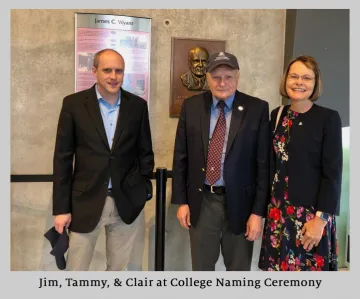
Giving back and paying forward have become fairly generic phrases, but ones that Jim takes to heart. Jim donates generously to show gratitude, and to inspire others to give—every gift is a thoughtful reflection of his life. His first few donations—stained glass windows in his hometown church in memory of his mother; a chair at the Institute of Optics in honor of his PhD advisor, Professor M. Parker Givens; a graduate scholarship at OSC in memory of his late wife, Louise (1942-2004); a track around the football field at CWRU in memory of his track and cross-country coach, Bill Sudeck—and each gift since honored mentors, role models and those close to him who have helped him become who he is today.
In recent years, Jim’s commitment to OSC and to optics education has inspired him to support optical sciences students and faculty at the University of Arizona. These gifts provide funding that helps OSC carry out its mission effectively today, and to plan accordingly for the future.
In 2013, Jim established a matching fund for graduate student scholarships. As a result of his initial gift, more than 250 additional donors contributed, resulting in the establishment of 30 first-year graduate student scholarship endowments, each bearing the name of the donor. In 2018, Jim and his family pledged to create 13 new endowed faculty positions at the College, again through a matching fund.
I have been very fortunate to be associated with OSC for over 40 years—as a professor, director, dean, and now as an emeritus professor. While the College has great facilities, the best thing is the people—the faculty, staff and students. The faculty have a broad range of optics expertise ranging from basic quantum optics to applied areas of optics to optical engineering, and they care about both their teaching and their research. The support staff are excellent, and the students are among the brightest.
Optics is a wonderful career where you can be a physicist, an engineer, an entrepreneur, or a combination of the three. It is so much fun giving the students the opportunity to have a career in optics and enjoy optics as much as I have. Following their careers after they leave OSC is extremely enjoyable—and knowing that in some way I have helped them—gives me great pleasure and satisfaction.
In 2019, for his role as founding dean of the College of Optical Sciences; for his dedication to inspire through teaching; for pioneering innovations in optics and photonics; and for his deeply generous philanthropy to enable education in optics, the University of Arizona honored Jim by naming OSC the “James C. Wyant College of Optical Sciences.”
